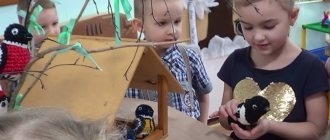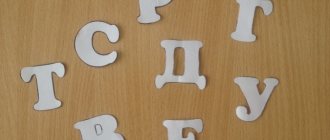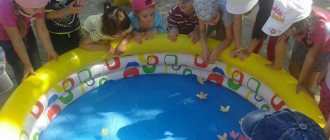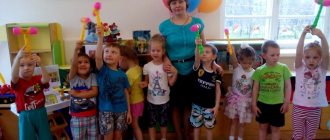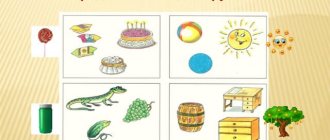Topic: Methodology for planning various types of work activities of preschoolers.
Plan:
1. Determination of the goals, objectives, forms of labor organization, methodological techniques, necessary equipment, types of individual work in the process of work of preschool children.
2.Methodology for developing planning skills for future work activities in preschoolers.
In a child’s work life, his own creative activity is of great importance: thinking about the upcoming activity, selecting the necessary materials and tools, overcoming known difficulties in achieving the intended result.
Preliminary planning of activities is most often carried out by the teacher. It should be borne in mind that it should not take more time than the labor process itself.
Children aged 5-7 years can also do basic planning. The ability to plan activities develops gradually from those simple actions that must be performed in a logical sequence. At first, this is difficult for the child.
But even when working with children of primary preschool age, it is possible to build requirements in such a way that regime processes open up opportunities for gradually teaching them to act in an organized manner, to be able to identify what needs to be done first, what next, and why it needs to be done in this and not another sequence. For example, the teacher suggests that the children tidy up the group room before leaving for a walk. He must explain to the children: first they need to put the chairs back in place, and then put the toys away. When washing, you must first roll up your sleeves so as not to get them wet, and then wash your hands, and wash your face with clean hands, etc. Thus, the sequence of actions is determined by the teacher, and children gradually learn to adhere to this sequence of actions. Based on these elementary simple approaches to planning the actions of a small child, the opportunity is gradually being prepared for the transition to more complex forms of planning in working with children of middle and older preschool age. It should be borne in mind that without training, children do not develop the ability to plan activities for a long time, and in the play of not only children of the younger, but often also the middle group, primitive manipulation of objects remains for a long time.
In some of the most common work processes organized in the middle and senior groups, a logical sequence of actions must be determined, representing the simplest plan of activity for the child. For example, when caring for indoor plants, they need to be positioned so that it is convenient to wipe and water them. To do this, you first need to transfer the flowers from the windowsill to the table, then wipe the leaves, wash the trays, water the plants, wipe the window sills and after that transfer the plants to their place. In the absence of an action plan, children's activities are chaotic.
Lena, having understood the purpose of the task - to wipe and water the flowers, immediately began to complete it. I wiped the plants right on the windowsill, despite the fact that it was high. The girl raised herself on her toes, but she couldn’t reach it anyway. Then she pulled up a chair. In response to the teacher’s remark that it was necessary to rearrange the pots so that it would be convenient to wipe them and water the plants, Lena simply moved them closer to the edge of the window sill. It was uncomfortable for her to work in this position. Sveta performed a similar task. When the teacher asked how we would care for the plants, Sveta said: “I’ll bring some water and water it.” To the question: “What will you do first?” - She answered: “I will water it.”
The children understood the goal - they need to put the indoor plants in order. Their activities are aimed at completing the assigned task, and this can be considered as expedient work activity. However, here the teacher is faced with the task of directing the children’s attention in the process of work to a logical sequence of actions that can lead to a better result (less expenditure of effort, time, better amenities). When repairing books with older children, you should first select the books that need repair. Then determine what needs to be done to put them in order: glue the pages, replace the spine, strengthen the corners of the cover. After this, prepare the necessary material: select the most suitable color paper, pieces of cardboard, glue, brushes, scissors. The process of work itself is also important to construct in such a way as to provide for the sequence of its implementation: inspect the book that needs to be repaired, determine by eye or using a ruler the width and length of the strip of paper that will need to be glued to the torn page, make notes with a pencil, and then cut it off and only after that stick it on. If a child’s activity is not directed, he performs many unnecessary actions and performs work in a sequence that does not ensure the achievement of the desired result.
Vera (6 years old) took a book, smeared the spine with glue, glued a piece of paper to the spine, the piece of paper turned out to be too big, it covered the picture on the cover, and there were extra pieces of paper left at the edges. The torn and folded corners of the cover remained unrepaired. Vera trimmed the excess paper along the edge, but unevenly. Vera responded willingly to the teacher’s offer to put another book in order. She wanted to use the same technique, but she was asked to first think about how to do it, remember how they glued books in class. Vera tried to mark the size of the book on a piece of paper, but she did it inaccurately, without a ruler, but even such trying on gave results. Vera had already smeared glue on a piece of paper, not the spine, because she was convinced that in the first case the pages of the book stick together and it is difficult to open it later. Now the result is much better. In the absence of planning skills, the child takes the path of trial and error, which leads to pointless waste of energy and causes a feeling of dissatisfaction with the result obtained.
The ability to plan activities is most successfully developed in the labor process, since in play the child is more subordinate to a free plan, which, during the game, often undergoes changes, often caused by random impressions and associations. In classes, the plan is most often proposed by the teacher, since here the main task is to teach the child what he does not yet know how to do. Only in classes of a creative nature are the tasks offered to independently solve a problem, the main questions of which are also most often given to the child in a ready-made form (come up with a story based on basic questions, according to a plan given by the teacher, glue a toy from a finished pattern, etc.). In order to teach a child to plan his activities, you need to give him an example. It is important to train the child in preliminary thinking about his activities. Children are asked questions: “Think about what you will do, where will you start? What tool will you use first? How much material will you need?
Children should be placed under conditions of the need to first think about the process of activity. If the work task is clear, older preschoolers complete the work independently and successfully. When some parts of the labor process are unknown to them, they find a solution during the work - they master new operations, use different tools, think about what material is needed for this work and how to use it! It is important for the teacher to find out the nature of the children’s motives and, in necessary cases, provide assistance, directing them to further searches for successful completion of the work. Children are given tasks both similar to those that were given earlier with explanations from the teacher, and new ones, in solving which the child can rely on his existing experience: repairing cardboard boxes for didactic games, tying up the stems of climbing plants, making a wooden table, washing a doll's room. clothes.
This is how children learn to plan work in special labor processes. Improving the skill of planning activities occurs in daily work (on duty, caring for the inhabitants of a corner of nature). It is important that in this work children do not act randomly or chaotically, but think through the sequence of operations.
At first, children strive to immediately, without prior reflection, begin performing a work task. When asked how many strips of paper need to be prepared to glue the corners of the box, the children answer: “A lot,” or remain silent, finding it difficult to answer. Children also answer the question: “How many planks do you need to make a table?” And to the question: “What tools do you need for this?” - most often the answer is: “Different.” When repeating a similar task, children imagine the labor process more specifically. So, when asked what materials are needed to make a table, Tolya answers: “One large plank for the table top and four small flat ones for the legs.” To the question: “How will you make the table?” - the child answers, showing how he will do it: “First I’ll pin one leg, on this side (points to the back of his hand)... This will be a table... And then the other leg... This is the leg” (puts a finger).
Vera (6 years 5 months) when asked what is needed to make a table, answers: “You need planks, a hammer and nails to nail it on.” - “How many planks do you need?” - “Four... or no, five. One is big and the rest are small.” “How will you make the table?” - “First, like this (shows with a movement of his hands, then takes a book and pencil). This is the table itself, and this is the leg.” The child easily depicts an action, implying real objects. To the question: “How will you wash the dolls’ clothes?” - she answers: “First I’ll pour water into a basin, and then I’ll wet the dress and soap it with soap and rub it like that. And then I’ll pour out the dirty water, pour in clean water, wash it again, and then rinse it. When it’s dry, I’ll iron it.”
Children can see labor actions in pictures depicting different types of people’s labor and talk about them. For example, the teacher offers pictures that depict different labor processes: planting trees, digging beds, picking apples, shining shoes, doing laundry. Children are asked to make up a short story based on the picture. As children gain experience in planning specific work, they can easily cope with such tasks.
Practical lessons:
1.Development of lesson notes on developing self-service skills in children of primary preschool age.
| 2. Development of a lesson plan on organizing household work with children of middle preschool age. |
3.Development of lesson notes for children of the senior group on caring for animals and plants.
| 4. Development of a lesson plan for organizing collective manual labor with children of the preparatory group (plot composition from natural material based on folk tales). |

